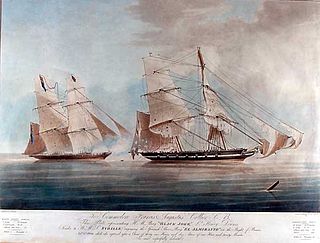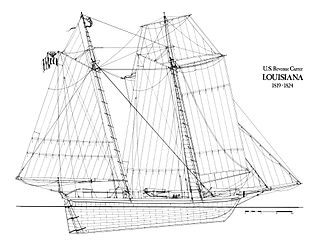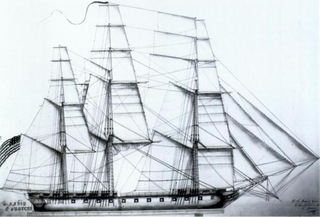Career
On 20 March 1823 HMS Grecian captured the pirate schooner La Gata, a felucca, and two boats. The Navy acquired Gata and took her into service as Lion. Her initial role was ship's tender to HMS Serapis, which was serving as a storeship at Jamaica.
Lieutenant William Hobson commissioned Lion in March.
On 28 March Lion and Union, Lieutenant Marriott, commanding, were in the Colorados Archipelago off the northwest coast of Cuba when they observed a large schooner. They gave chase until the schooner's crew ran her onto a beach and abandoned her after first setting fire to her. The British took possession of the schooner and removed her cargo, which consisted of goods plundered some time before from a French vessel. The schooner carried three heavy guns, was marked on her mast and sails with the number "104", and had been full of men. The British destroyed her before they left. [2] [lower-alpha 1]
The next day the British came upon a sloop anchored near the shore in Baja Bay. Lion and Union sent in their boats, together with two launches from HMS Tamar. As they approached the sloop they came under heavy fire from men gathered on the shore. The fire lasted for four-and-a-half hours before the sloop apparently was able to escape, at which time the pirates on shore dispersed into the woods. It was later ascertained that there were some 160 men, consisting of the crew of "104", men from "La Gata", who had escaped when Grecian had captured her, and men from a schooner that the British captured the next day. The pirates had sustained casualties of two men killed and several men wounded; the British suffered no casualties. The British found a schooner of 80 tons (bm) and one gun moored up a narrow creek, apparently being fitted out for a pirate cruize. The British burnt her. [2]
On 30 March Lion, Union, and Tamar were in Las Carnas Bay in the Colorado Reefs when they came upon a third schooner, this of 80 tons (bm), and armed with one large gun on a pivot mount. When Lion, Union, and two launches from Tamar approached, the crew of the schooner ran her onshore and escaped into the woods. Lion and Union then brought the schooner into Port Royal. [2]
Tamar parted from Lion and Union on 5 April, bound for Vera Cruz and Portsmouth. [2]
On 5 June Lion and Union captured Flor de la Mar. [3]
On 6 July 1823 Lion and Union, and boats of HMS Tyne captured a pirate felucca. [3]
Hobson received a promotion to Commander on 18 March 1824. His replacement as captain of Lion was Francis Liardet, who was promoted to Lieutenant and command on 18 March. During his tenure, Lion participated in the destruction of several nests of pirates on the coast of Cuba, and captured nine of their vessels, some of their prizes, and a slave ship.
On 26 June Lion and Assiduous captured a pirate schooner. [3]
On 24 November the French ship Calypso, Ducoumier, master, arrived at Key West with a full cargo of coffee. Pirates had captured Calypso as she was on her way to Havre from St Domingo. The pirates had killed half the crew; the rest had jumped overboard. The schooners USS Beagle and Lion had recaptured Calypso, together with her pirate crew. [4]
On 14 December 1824 Lion, Lieutenant Liardet commanding, captured the slave ship Relampago (Sp: lightning flash), at 23°8′N79°17′W / 23.133°N 79.283°W / 23.133; -79.283 , about 200 miles east of Havana. Lion and Relampago arrived at Havana on 18 December. There Lieutenant Liardet stated to the Court of Mixed Commission that Lion was a tender to HMS Carnation, and that Captain Maclean of Carnation was authorized to seize Spanish vessels engaged in the illicit slave trade. Carnation arrived at Havana on the 19th, and the mixed commission condemned Relampago on the 23rd. The court found that Relampago, Don Lucas Padron, owner, and Don Jozé Garay, master, had sailed from Havana in May for Africa with papers indicating that she was intending to trade in lawful commerce and not engage in the slave trade. When captured, Melampago had 159 slaves on board, having embarked some 162, with three having died on the way; another eight died while the case was being heard and one man was missing, believed to have fallen overboard due to extreme weakness. Liardet was able to land 150 persons, but two more died while their certificates of emancipation were being prepared. Captain Garay testified that he had accepted the slaves in payment for the goods he had brought, the King at Mesarcoh (Grand Mesurado) being unwilling to pay with gold dust or other commodities. The captain had also taken on board six men from the Spanish schooner Biscayna, which had been lost on the coast of Africa. [5] [6] [lower-alpha 2]
In March 1825, the frigate HMS Dartmouth, the schooners Lion and Union, and the USS Gallinipper participated in an operation against Cuban pirates. United States Navy Lieutenant Isaac McKeever led an attack against a schooner at the mouth of the Sagua la Grande. American and British forces took the schooner. The attackers killed eight pirates and captured 19 more; the attackers' casualties were only one man wounded. On the following day, the force captured another schooner but the pirates escaped and the vessel was taken without bloodshed. Lion brought the captured pirates into Kingston.
On 5 October 1825 Lion, under the command of Lieutenant Edward Smith, captured the Spanish brigantine Isabel. Isabel, Pedro Blanco, master, had sailed from Havana on 1 August 1824. She had acquired slaves at Gallinhas. When Lion captured Isabel her master was Vicente Gomez, and she had 50 slaves aboard. It is possible that Gomez had stolen Isabel while her owner was on shore buying slaves. When Lion started to pursue Isabel, Gomez ran her on shore. He escaped ashore, together with his crew and most of the slaves. Lion retrieved Isabel and the ten slaves still onboard, and brought them into Havana where the Court of Mixed Commission condemned her. [9]

The third HMS Black Joke was probably built in Baltimore in 1824, becoming the Brazilian slave ship Henriquetta. The Royal Navy captured her in September 1827 and purchased her into the service. The Navy re-named her Black Joke, after an English song of the same name, and assigned her to the West Africa Squadron. Her role was to chase down slave ships, and over her five-year career she freed many hundreds of slaves. The Navy deliberately burnt her in May 1832 because her timbers had rotted to the point that she was no longer fit for active service.

Sibylle was a 38-gun Hébé-class frigate of the French Navy. She was launched in 1791 at the dockyards in Toulon and placed in service in 1792. After the 50-gun fourth rate HMS Romney captured her in 1794, the British took her into service as HMS Sybille. She served in the Royal Navy until disposed of in 1833. While in British service Sybille participated in three notable single ship actions, in each case capturing a French vessel. On anti-slavery duties off West Africa from July 1827 to June 1830, Sybille captured numerous slavers and freed some 3,500 slaves. She was finally sold in 1833 in Portsmouth.

HMS Calypso was a Royal Navy Cruizer-class brig-sloop. She was built at Deptford Wharf between 1804 and 1805, and launched in 1805. She served in the North Sea and the Baltic, most notably at the Battle of Lyngør, which effectively ended the Gunboat War. Calypso was broken up in March 1821.

HMS Arab was a 22-gun post ship of the Royal Navy. She was formerly the 18-gun French privateer Brave, which the British captured in 1798. She served during the French Revolutionary and Napoleonic Wars until she was sold in 1810.
The Capture of the schooner Bravo was a naval battle between United States Revenue Cutter Service cutters and one of Jean Lafitte's pirate ships.

USRC Louisiana, was a wood hull topsail schooner designed by William Doughty that was commissioned in the United States Revenue Marine from 1819 to 1824. Assigned the homeport of New Orleans, Louisiana, she sailed the Caribbean extensively and was used mainly in anti-piracy activity.

The action of 9 November 1822 was a naval battle fought between the United States Navy schooner USS Alligator and a squadron of three pirate schooners off the coast of Cuba during the Navy's West Indies anti-piracy operation. Fifteen leagues from Matanzas, Cuba, a large band of pirates captured several vessels and held them for ransom. Upon hearing of the pirate attacks, Alligator under Lieutenant William Howard Allen rushed to the scene to rescue the vessels and seize the pirates.

The West Indies Squadron, or the West Indies Station, was a United States Navy squadron that operated in the West Indies in the early nineteenth century. It was formed due to the need to suppress piracy in the Caribbean Sea, the Antilles and the Gulf of Mexico region of the Atlantic Ocean. This unit later engaged in the Second Seminole War until being combined with the Home Squadron in 1842. From 1822 to 1826 the squadron was based out of Saint Thomas Island until the Pensacola Naval Yard was constructed.
HMS Nimble was a Royal Navy 5-gun schooner-of-war. She was employed in anti-slave trade patrol from 1826 until 1834, when she was wrecked on a reef with the loss of 70 Africans who had been rescued from a slave ship.

HMS Monkey was a schooner of the British Royal Navy assigned to the West Indies squadron, launched in 1826 at Jamaica. She made three notable captures of slavers, one involving a single-ship action against a slaver much larger and more heavily armed than herself. She was wrecked in 1831 near Tampico.

The West Indies Anti-Piracy Operations refer to the United States Navy presence in the Antilles, and surrounding waters, which fought against pirates. Between 1817 and 1825, the American West Indies Squadron constantly pursued pirates on sea and land, primarily around Cuba and Puerto Rico. After the capture of Roberto Cofresi in 1825, acts of piracy became rare and the operation was considered a success although limited occurrences went on until slightly after the start of the 20th-century.
HMS Galgo was a Jamaican privateer that the Spanish Navy captured in 1797 and named Galgo Inglés, and that the British captured in November 1799. In her brief career she detained, took, or destroyed a number of small prizes before October 1800, when she foundered, with the loss of most of her crew and passengers.
HMS Speedwell was the mercantile Royal George, which the Royal Navy purchased in 1815 and converted to a 5-gun schooner. During her career in the West Indies, she helped capture or destroy a number of pirate vessels, and capture several slave ships. The Royal Navy sold her at Jamaica in 1834.
HMS Union was the mercantile City of Kingston that the Royal Navy purchased in 1823 for service as a 3-gun schooner. She served in the suppression of the slave trade in the West Indies. She was wrecked in 1828.
HMS Grecian was the former Revenue cutter Dolphin, launched at Cowes in 1799, that the Royal Navy purchased in 1821 and renamed. She captured a pirate schooner in 1823. The Royal Navy sold Grecian in 1828.
HMS Barbadoes was a 16-gun vessel, the American Herald, captured in 1813. The Royal Navy took her into service as HMS Barbadoes She captured a number of merchantmen and privateers before she was paid-off in May 1816. In 1814–1815 she also captured three Spanish and French vessels carrying over 1100 slaves. Barbadoes became a powder ship in Jamaica that was later wrecked with her remains being sold.
HMS Tyne was launched at Topsham in 1814 as a Conway-class sixth rate. She served in the East Indies and in the Pacific Squadron. She also served in the Caribbean, cruising against pirates, during which she captured the pirate schooner Zaragozana. In 1825 the Navy sold Tyne and she became a whaler. She was lost in early 1827 in the Bonin Islands on her first voyage to the British southern whale fishery.
HMS Renegade was a schooner built in the United States in 1820, or possibly even earlier. She had been the pirate ship Zaragozana operating out of Havana that the British Royal Navy captured on 31 March 1823 and took into service. The Navy sold HMS Renegade in January 1826.
HMS Assiduous was the former pirate vessel Jackal, captured in 1823. On 24 June 1824 Assiduous and HMS Lion captured a pirate schooner. Lieutenant Richard Dowse commissioned Assiduous in November 1824. After HMS Lion, a tender to HMS Carnation, captured the slave ship Relampago, Carnation, Union, and Assiduous set out in pursuit of another slaver. They chased her into Cardinas. There the Spanish authorities refused to permit the British permission to seize her, despite an inspection revealing that she had carried slaves. The vessel was Magico, and Union finally captured her in 1826.








